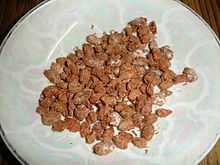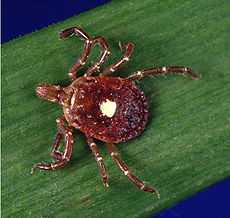Trombidiidae
| Red velvet mite | |
|---|---|
 | |
| Trombidium sp. | |
| Scientific classification | |
| Kingdom: | Animalia |
| Phylum: | Arthropoda |
| Subphylum: | Chelicerata |
| Class: | Arachnida |
| Subclass: | Acari |
| Order: | Trombidiformes |
| Suborder: | Prostigmata |
| Superfamily: | Trombidioidea |
| Family: | Trombidiidae |
Anystides Red Velvet Mites or Rain Bugs are arachnids found in soil litter known for their bright red colours but are often mistaken for spiders. They are active predators as grown adults but as early instars are often parasites on insects.[1] It is also called Bir ba boti in the Indian subcontinent. In the state of Odisha in India, they are often called as Paata Poka because of its smooth velvet skin.
The pattern of stages is shared with that of other members of the Prostigmata: egg, pre-larva, larva, protonymph, deutonymph, tritonymph and adult (male or female). They usually have only one breeding cycle per year.[2]
One well known species from the Palearctic is Trombidium holosericeum.
The systematics of this group has been in flux and many former subfamilies of this are now raised to families within the Trombidioidea.[2][3]

The oil from the red velvet mite Trombidium grandissimum is used in traditional Indian medicine to treat paralysis. Also, due to their alleged ability to increase sexual desire, Trombidium mites are known locally as "Indian Viagra."[4]
References
- ↑ L. Conradt, S. A. Corbet, T. J. Roper, E. J. Bodsworth (2002) Parasitism by the mite Trombidium breei on four U.K. butterfly species. Ecological Entomology 27(6):651-659
- ↑ 2.0 2.1 Zhang, Zhi-Qiang (1998) Biology and ecology of trombidiid mites (Acari: Trombidioidea) Experimental & Applied Acarology 22:139-155 PDF
- ↑ Makol, Joanna (2007) Generic level review and phylogeny of Trombidiidae and Podothrombiidae (Acari: Actinotrichida: Trombidioidea) of the world. Annales Zoologici 57(1): 1-194
- ↑ Oudhia, P. 1999b. Traditional medicinal knowledge about red velvet mite Trombidium sp. (Acari: Trombidiidae) in Chhattisgarh. Insect Environment 5(3):113.
External links
| |||||||||||||||||||||||||||||||||||||||||||||||||||||||||||||
